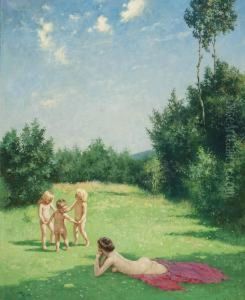William Witting Paintings
William Witting was a Finnish painter, best known for his landscapes and portraits. Born on November 24, 1884, in Viborg, which at the time was part of the Grand Duchy of Finland within the Russian Empire, Witting was exposed to art from a young age. He showed an early interest in painting and went on to study at the Finnish Art Society's drawing school in Helsinki, which was the central hub for art education in Finland at the time.
After completing his studies in Finland, Witting traveled extensively to further his education and gain inspiration. He spent time in Paris, which was the epicenter of the art world during the early 20th century. There, he absorbed the influences of contemporary art movements, which can be seen in the evolution of his painting style over the years.
Witting's work is characterized by a strong command of light and shadow, a reflection of the changing seasons and the unique landscapes of his native Finland. His portraits are noted for their psychological depth and the ability to capture the essence of the sitter. Throughout his career, Witting exhibited his work widely, gaining recognition in Finland and abroad. He participated in several exhibitions, including the Finnish Artists' Exhibitions, and his works were also shown in the Baltic exhibitions in Malmö in 1914 and in Stockholm in 1916.
During his career, Witting was also a teacher, sharing his knowledge and skills with the next generation of Finnish artists. His influence on Finnish art was significant, as he helped to shape the visual culture of his country during the first half of the 20th century.
William Witting's contribution to Finnish art was recognized with various awards and honors throughout his lifetime. His paintings remain in many public and private collections, serving as a testament to his talent and dedication to his craft. Witting passed away on February 3, 1949, leaving behind a rich legacy of Finnish artistry that continues to be celebrated to this day.
